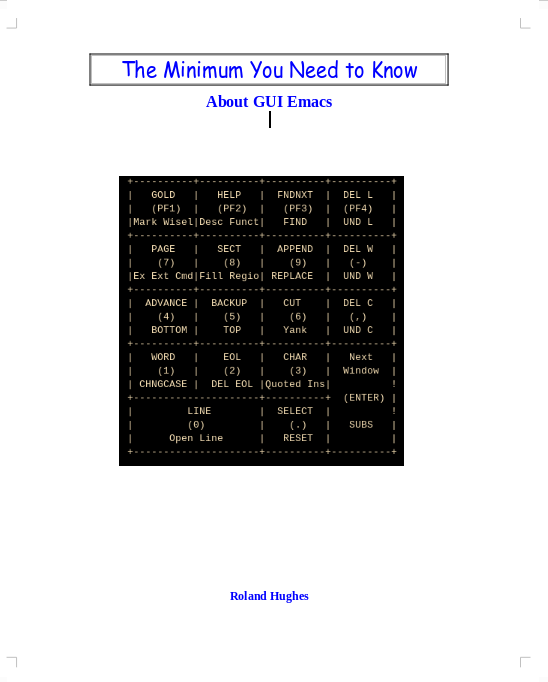

ISBN-13: 978-1-9397321-1-1 paperback
ISBN-13: 978-1-9397321-0-1 hardcover
Retail price:
$45 paperback
$55 hardcover
Purchase From:
Barnes&Noble
About the Book
Emacs has a long well earned reputation of being "expert friendly." Most every other book on Emacs strives to show just how many cryptic keystroke combinations the author can remember. They include tons of author written eLisp blocks of code that are unmaintained. Many of them cease to work a scant few years after the book is published because Emacs changes.
GUI Emacs, once EDT Emulation is installed and enabled, requires you to remember very few cryptic keystrokes. Most basic editing functions can be accomplished via the numeric keypad. You can even print out the keypad mapping (found on the front cover of this book) and keep it handy until muscle memory kicks in.
Many of the more involved things one wishes to do with their editor are already on the GUI menu. No need to learn either eLisp or cryptic keystrokes. "Expert Friendly" not spoken here.
EDT is an editor that started out on the DEC midrange PDP computers in the 1960s. It started before we had such fancy things as arrow keys, page up, page down, etc. Most numeric terminals did have a numeric keypad because they were used for data entry. EDT leveraged this by setting the keypad to application mode and re-purposing the keys for edit and navigation functions. This book covers part of that history so the reader understands the "why" of things.
Introduction of the mouse mostly ruined text (especially program) editing. It isn't just the extra reach of the hand dooming efficiency, it's the breaking of concentration scanning the screen to find the mouse pointer then deciding where it needs to go. Anyone who has typed for any length of time knows that your fingers soon learn where the keys are. This is true for the numeric keypad as well. Navigation, selection, cut & paste, change case, special character insertion, and many other things can be done via the numeric keypad without having to break concentrations. After a bit your fingers "just know" the keys. In the mean time you can print out the image from the Help screen for the day or so you need it.
This book walks you through the early history explaining the "why" of things. It shows you how to obtain and install Emacs along with some support packages for the cooler features. It even gives you an introduction to using Emacs as a front end for GDB (Gnu Debugger) so you can use Emacs like a full IDE.
The author of this book spent two decades in the DEC midrange world before moving to embedded systems and medical devices. Once you learn how incredibly intuitive EDT Emulation is, all other editors will seem wretched.
Copyright © 2007-2024 Roland Hughes. All rights reserved. TheMinimumYouNeedtoKnow.com. The information on this page may not be reproduced or republished without prior permission from Roland Hughes.
